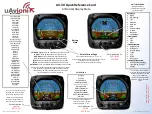
13
ENG
Function and structure
WTS LARGE +0300131IT rel. 1.0 - 05.09.2022
4.3.1 Recovery value
You can optimise the permeate production by adjusting the flow rates (Ref. 1). The basis for this is the respective
recovery value of the plant (see technical data). If the recovery value is 68%, this means a permeate production quantity
of 68% of the feed water used for this purpose. The difference to 100% shows the concentrate share.
You can optimise permeate output by adjusting the flow rates (Ref. 1). The basis for this is the relevant recovery value of
the system (see technical data). For example, the recovery value for the ROL320 is 68% at a raw water temperature of 18
°C and a TDS value of 500 ppm.
The recovery value is calculated as follows:
RECOVERY (%) = Permeate 100
(Pe Concentrate)
Regulate the flow rate of the concentrate through the BV03* valve and read it off the FI03* flow meter. The circulation
is controlled by the BV02* valve and read off at the FI02* flow meter. The pressure regulated in this way on the
membranes guarantees the spe- cified production output.
The feed water temperature clearly influen- ces both productivity and the quality of the permeate. If the temperature
rises (even by only a few degrees), productivity increases (which results in a better recovery value); however,
conductivity increases at the same time.
* see chapter: Commissioning
Ref.1
A Permeate flow meter
B Recirculation flow meter
C Manual recirculation control valve
D Permeat conductivity probe
E Attachment for sampling permeat
F Flushing solenoid valve
G Manual flushing control valve
H Manual drain control valve
I Drain flow meter
4.4 Operating sequence
The feed water (raw water) is pumped through the pre-filter, which guarantees the dechlorination and a final filter
capacity of 5 µm. This ensures the necessary clarity of the water at the membrane inlet. It is next softened by the
addition of an antiscalant. The feed water pressure must be at least 2 to 5 bar during normal operation to ensure a
correct supply pressure at the pump inlet.
The
water then flows through the water inlet solenoid valve SV1
and is then directed by the pressure pump at high
pressure to the membrane(s).
The
pressure switch PS HIGH
provides a signal when the pressure exceeds 12 bar at the membrane inlet.
Pure water (permeate) passes through the membrane; the salts solved in the water are retained by the membrane and
drained off (concentrate).
The permeate now flows via the pure water line (scope of delivery) to the expansion ves- sel or directly to the consumer.
The quality of the permeate leaving the system is controlled by the c
onductivity sensor (EC PROBOUT)
.
The production process stops automatically when the water outlet pressure has reached approx. 4 bar at the
pressure
switch PS MAX
. The pressure in the following circuit is kept constant by the expansion vessel.
If the pressure in the following circuit at the
pressure switch PS MIN
falls below 2 bar (when the expansion vesel is
empty), the unit starts permeate production again.
If the inlet pressure falls below 0.8 bar, the pressure switch
PS LOW
gives the corre- sponding alarm and interrupts
operation.
The permeate production quantity achieved can be read off from the permeate flow rate display (Ref1). If this does not
correspond to the the specifications in the technical data, please note the measures mentioned in chapter 4.2.
Notice:
The reverse osmosis (R.O.) units of the ROL series cannot operate without an expansion vessel or permeate
collecting tank.
Summary of Contents for Large ROL 160-1K2
Page 2: ......
Page 6: ......
Page 43: ...43 ENG Control WTS LARGE 0300131IT rel 1 0 05 09 2022...
Page 59: ...59 ENG Spare parts WTS LARGE 0300131IT rel 1 0 05 09 2022 20 21 22 23 24 25 26 27 28 29 30...
Page 65: ...Notes...
Page 66: ...Notes...
Page 67: ......














































